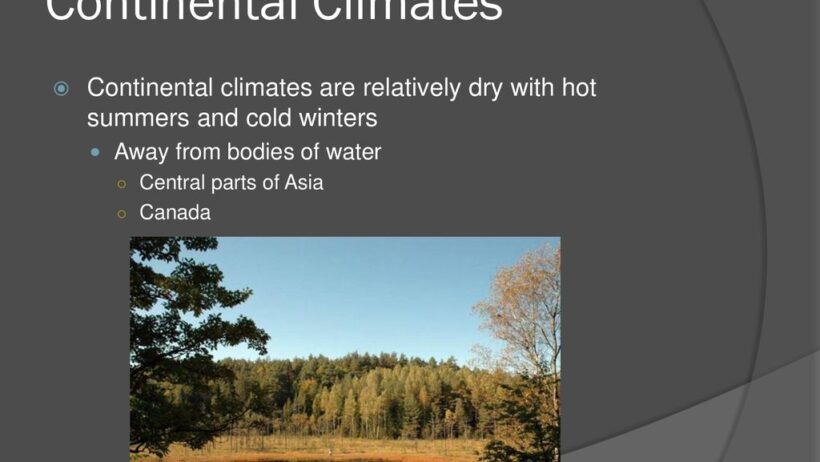Continental climates, characterized by their distinct seasonal variations, present a fascinating subject for exploration. These climates typically manifest in the interior regions of continents, far removed from the moderating influence of oceans. This geographical positioning engenders significant temperature fluctuations between summer and winter. Through a comprehensive examination of continental climates, one can delve into their underlying features, the intricacies of their weather patterns, and the broader implications for ecosystems and human activity.
The most defining aspect of continental climates is the pronounced temperature gradient between the seasons. Summers are known for their warmth, often rampant with sweltering heat, while winters plunge into frigid cold. This stark contrast arises due to the low capacity of land to retain heat, unlike large bodies of water, which have a moderating effect on climate. During the summer months, the sun’s rays bombard the land more directly, leading to higher temperatures. Conversely, in winter, the land loses heat rapidly, resulting in colder conditions, sometimes accompanied by snowfall.
Continental climates can be further classified into subcategories, primarily influenced by geographical latitude and altitude. The major types include humid continental, subarctic, and continental Mediterranean climates. Each type presents unique characteristics, yet all share the commonality of temperature extremes and relatively low precipitation.
Humid continental climates, prevalent in regions such as the northeastern United States and parts of Eastern Europe, exhibit a great deal of humidity during the growing season. This humidity can support rich agricultural practices, but it also requires adequate water management during the drier winter months. The growing season is typically long enough to support a variety of crops, making these regions crucial for both local and national food supplies.
In contrast, the subarctic climate, found in the northern reaches of Canada and Russia, is marked by even more severe winters. Temperatures can plummet significantly, and the summer months remain fleeting, leaving little time for the recovery of the flora. This climate type supports a different set of ecological adaptations; coniferous forests dominate the landscape, adapted to withstand the long, harsh winters. The fauna in these regions has also evolved, with species like the snowshoe hare and lynx exhibiting remarkable adaptations to thrive under these conditions.
The continental Mediterranean climate, found in areas such as parts of California and the Mediterranean Basin, breaks the mold slightly by experiencing a distinct dry season. Summers can be oppressively warm, with minimal precipitation, while winters bring cooler, wetter conditions. This type of climate nurtures unique ecosystems, including chaparral in California, where plants have adapted to survive in dry conditions through various mechanisms, such as waxy leaves and deep roots.
The factors influencing the onset and persistence of continental climates extend beyond mere geography. Meteorological phenomena, such as the jet stream and prevailing wind patterns, also play a critical role. The lack of nearby water bodies means that air masses can travel long distances over land, picking up or shedding moisture as they move. This contributes to the often dry winters that characterize many continental climates. Moreover, the presence of mountains can create rain shadows, where one side of the mountain range receives significant precipitation while the other remains arid.
Precipitation in continental climates is generally lower than in marine-influenced climates. Rainfall is often concentrated in the summer months, driven by convective activity during hotter periods. Thunderstorms can develop rapidly, sometimes delivering torrential downpours, but these events are generally sporadic. The cumulative effect leads to dry conditions during the winter, resulting in distinct seasonal cycles that can adversely affect agriculture and biodiversity.
The implications of continental climates for both ecosystems and human societies are profound. Agriculture in these regions demands careful planning and management, particularly in light of the potential for drought during the dry winter months. Understanding the seasonal patterns allows for the selection of appropriate crops that can thrive under such conditions. Similarly, urban planning must take into account the potential for extreme weather occurrences. Heatwaves in summer and blizzards in winter require robust infrastructure and emergency response systems to protect the populace.
Moreover, the changing dynamics of climate change pose an additional layer of complexity. As global temperatures rise, the characteristics of continental climates may shift, leading to altered precipitation patterns and temperature norms. Increased frequency of droughts or, conversely, torrential rainfall could disrupt established agricultural practices and endanger regional ecosystems. Effective response strategies and adaptive management practices will be essential for mitigating these risks.
In conclusion, continental climates exemplify the intricate interplay between geographical location, meteorological phenomena, and ecological adaptation. The dynamics of dry winters and warm summers create environments that are both unique and challenging. A comprehensive understanding of these climates, their characteristics, and their implications is crucial for effective environmental and agricultural practices. As humanity grapples with the pressing realities of climate change, the knowledge gleaned from studying continental climates becomes increasingly essential for ensuring sustainable interactions with our planet.





